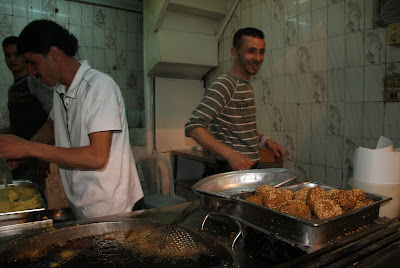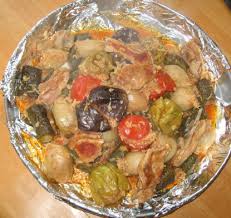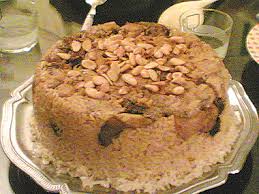Petra is certainly one of the most amazing places I've seen.
 On the right is a picture of the town of Wadi Musa (Valley of Moses) which is next to Petra, and the location that Christians believe Moses struck a rock from which water flowed. It is from this spring that the Nabataens built channels into the city of Petra. Petra (which is Greek for rock) was established in the 6th century BC as the capital city of the Nabataeans for two key reasons. Firstly, they could control the water in the area through a complex system of dams and conduits, creating an artificial oasis. Secondly, they could also control the trade routes (including the silk road and incense and spice routes) that linked China, India and Southern Arabia to North Africa, Greece and Rome, and collect lucrative taxes.
On the right is a picture of the town of Wadi Musa (Valley of Moses) which is next to Petra, and the location that Christians believe Moses struck a rock from which water flowed. It is from this spring that the Nabataens built channels into the city of Petra. Petra (which is Greek for rock) was established in the 6th century BC as the capital city of the Nabataeans for two key reasons. Firstly, they could control the water in the area through a complex system of dams and conduits, creating an artificial oasis. Secondly, they could also control the trade routes (including the silk road and incense and spice routes) that linked China, India and Southern Arabia to North Africa, Greece and Rome, and collect lucrative taxes.
To enter Petra, one must walk for about 2 kilometers, firstly through an open area, where you can witness cubical tombs carved out of rock, called "djinn houses" as the Bedouin thought they must be homes to spirits, as well as various residences carved into rocks. Apparently, these tombs and residences were for the poorest classes, and with the amount of work that went into the poorer abodes and tombs, one realises that Petra itself must be phenomenal.
Next, one reaches a 1.2km passage called the "Siq", which is a dry gorge, flanked by soaring 80m high cliff faces. The gorge dried up due to the Nabataens installing dams, and they also carved conduits into each side of the passage, with one side to carry drinking water, and the other to carry water for irrigation. At one point, you can even see a piece of clay pipe in the irrigation side, and it's amazing to think its about 2600 years old. Back in the day, the siq was the East entrance to Petra, and the North and South entrances were more popular, but these days only the Siq is used, due to its proximity to Wadi Musa, where most people stay when they visit Petra.
Along the way, there are also various intricately carved niches which used to display the busts of Arab Gods and Goddesses from pre-Islamic times, and also of their Kings. The main God they workshipped was Dushara with his trinity of Goddess wives. Sacrifices were regularly made to Dushara, and one can see holes in the rock around the niches where the Nabataens would insert the blood of the sacrifices which would slowly drip out, so that it looked like the rock was weeping blood. I imagine Dushara would have been impressed with the spectacle - I was with the concept.
Head already swimming with tales of religious rituals, ancient politics and power plays, the sights of rock carvings of Nabataen kings that wore Chinese shoes and camels, dams and irrigation, and beautifully coloured rocks of every shade of red and pink, orange and yellow, smells of horses clopping up and dwen the siq carrying tourists .... one marvels at the Nabataen civilisation....And then....as you reach the end of the Siq....you see this:
Enter, Petra!
The mind boggles!
This building was named The Treasury, but is in fact an ancient tomb to a Nabataen king and queen.

For my lawyer friends, you can see in the picture below an ancient court of justice complete with holding cells below:
In the second century AD, Petra became part of the Roman empire, and the Roman influence on the city is also very evident with an amphitheatre and roman columns. There is also the remains of a christian church.
In the fourth century AD, Petra was rocked by a series of earthquakes that detroyed many of the buildings. The earthquakes were that devastating that the city was abandoned. Over the many centuries that have since passed, the city was vulnerable to thieves, and all the treasures have been stolen. There were further eathquakes and more parts collapsed. So Petra now is very much a shadow of its former self, and still absolutely majestic and a true wonder of the world.
 On the right is a picture of the town of Wadi Musa (Valley of Moses) which is next to Petra, and the location that Christians believe Moses struck a rock from which water flowed. It is from this spring that the Nabataens built channels into the city of Petra. Petra (which is Greek for rock) was established in the 6th century BC as the capital city of the Nabataeans for two key reasons. Firstly, they could control the water in the area through a complex system of dams and conduits, creating an artificial oasis. Secondly, they could also control the trade routes (including the silk road and incense and spice routes) that linked China, India and Southern Arabia to North Africa, Greece and Rome, and collect lucrative taxes.
On the right is a picture of the town of Wadi Musa (Valley of Moses) which is next to Petra, and the location that Christians believe Moses struck a rock from which water flowed. It is from this spring that the Nabataens built channels into the city of Petra. Petra (which is Greek for rock) was established in the 6th century BC as the capital city of the Nabataeans for two key reasons. Firstly, they could control the water in the area through a complex system of dams and conduits, creating an artificial oasis. Secondly, they could also control the trade routes (including the silk road and incense and spice routes) that linked China, India and Southern Arabia to North Africa, Greece and Rome, and collect lucrative taxes.To enter Petra, one must walk for about 2 kilometers, firstly through an open area, where you can witness cubical tombs carved out of rock, called "djinn houses" as the Bedouin thought they must be homes to spirits, as well as various residences carved into rocks. Apparently, these tombs and residences were for the poorest classes, and with the amount of work that went into the poorer abodes and tombs, one realises that Petra itself must be phenomenal.
 |
| Djinn Houses |
 |
| Poorer abodes on the outskirts of Petra |
Next, one reaches a 1.2km passage called the "Siq", which is a dry gorge, flanked by soaring 80m high cliff faces. The gorge dried up due to the Nabataens installing dams, and they also carved conduits into each side of the passage, with one side to carry drinking water, and the other to carry water for irrigation. At one point, you can even see a piece of clay pipe in the irrigation side, and it's amazing to think its about 2600 years old. Back in the day, the siq was the East entrance to Petra, and the North and South entrances were more popular, but these days only the Siq is used, due to its proximity to Wadi Musa, where most people stay when they visit Petra.
 |
| The Siq |
 |
| Drinking water conduit on the left, carved out for the entire distance of the siq |
 |
| Clay pipe remains |
Along the way, there are also various intricately carved niches which used to display the busts of Arab Gods and Goddesses from pre-Islamic times, and also of their Kings. The main God they workshipped was Dushara with his trinity of Goddess wives. Sacrifices were regularly made to Dushara, and one can see holes in the rock around the niches where the Nabataens would insert the blood of the sacrifices which would slowly drip out, so that it looked like the rock was weeping blood. I imagine Dushara would have been impressed with the spectacle - I was with the concept.
 |
| The remains of a carving of a king wearing Chinese shoes |
 |
| A niche that housed Dushara |
 |
| A cheesy family shot in the Siq, where divorcees would stand when remarrying. I'm not sure if this equated to us renewing our vows or brought us one step closer to divorce. |
Head already swimming with tales of religious rituals, ancient politics and power plays, the sights of rock carvings of Nabataen kings that wore Chinese shoes and camels, dams and irrigation, and beautifully coloured rocks of every shade of red and pink, orange and yellow, smells of horses clopping up and dwen the siq carrying tourists .... one marvels at the Nabataen civilisation....And then....as you reach the end of the Siq....you see this:
Enter, Petra!
The mind boggles!
This building was named The Treasury, but is in fact an ancient tomb to a Nabataen king and queen.

For my lawyer friends, you can see in the picture below an ancient court of justice complete with holding cells below:
In the second century AD, Petra became part of the Roman empire, and the Roman influence on the city is also very evident with an amphitheatre and roman columns. There is also the remains of a christian church.
In the fourth century AD, Petra was rocked by a series of earthquakes that detroyed many of the buildings. The earthquakes were that devastating that the city was abandoned. Over the many centuries that have since passed, the city was vulnerable to thieves, and all the treasures have been stolen. There were further eathquakes and more parts collapsed. So Petra now is very much a shadow of its former self, and still absolutely majestic and a true wonder of the world.
 |
| Charlie hangs out reflecting on Petra's sites and how to talk her parents into a camel ride |
 |
| Charlie reaches a compromise and rides a donkey with a friendly Bedouin boy |


































